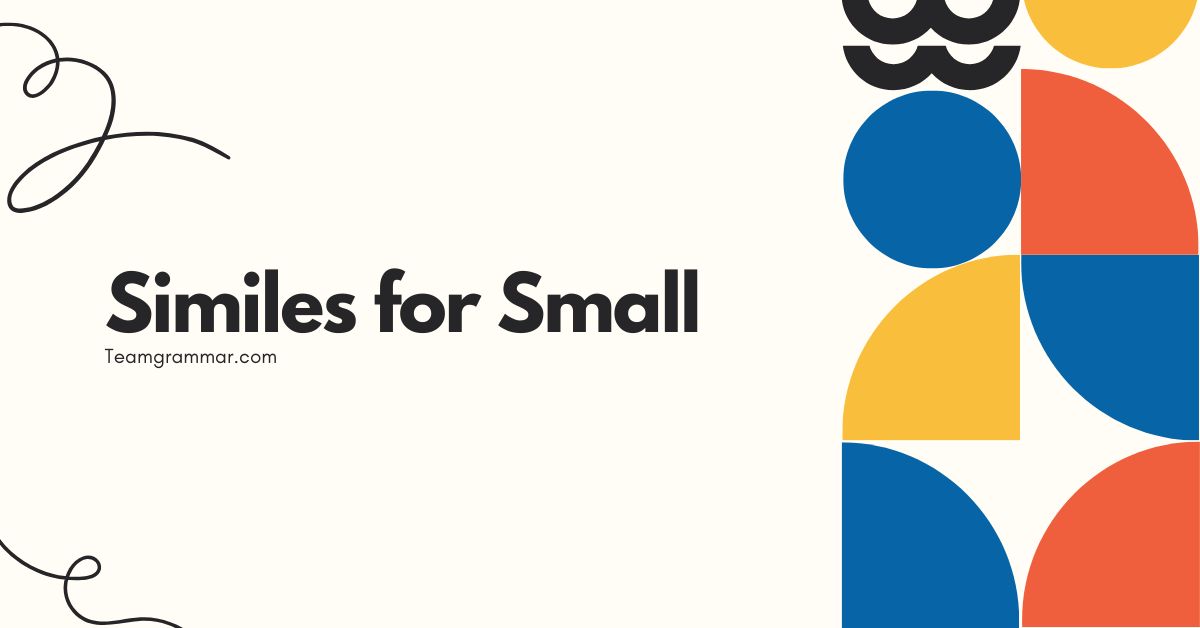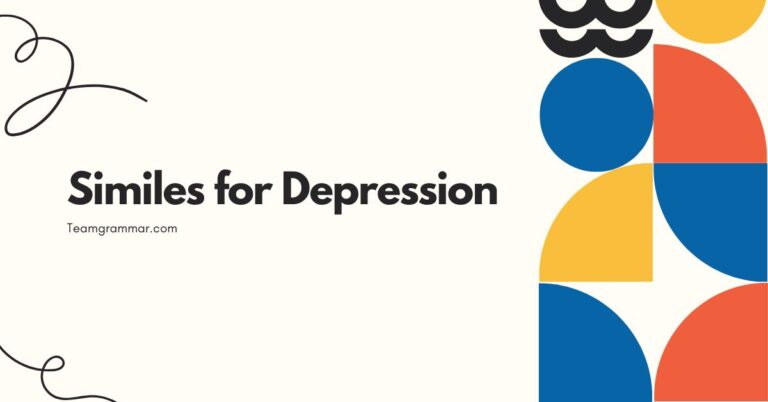41 Similes for Small: Mastering Figurative Language
Understanding similes is crucial for enhancing your descriptive writing and comprehension skills. Similes, which use “like” or “as” to compare two unlike things, add color and depth to language.
This article provides a comprehensive guide to similes specifically related to the concept of “smallness,” exploring their structure, usage, and impact. Whether you’re a student, writer, or language enthusiast, this guide will equip you with the knowledge and practice needed to effectively use similes to convey the idea of smallness in your writing and everyday communication.
Table of Contents
- Introduction
- Definition of Simile
- Structural Breakdown of Similes
- Types of Smallness in Similes
- Examples of Similes for Small
- Usage Rules for Similes
- Common Mistakes with Similes
- Practice Exercises
- Advanced Topics in Similes
- FAQ: Frequently Asked Questions
- Conclusion
Definition of Simile
Asimileis a figure of speech that compares two different things using the words “like” or “as.” The primary function of a simile is to create a vivid image or to emphasize a particular quality by drawing a parallel between two dissimilar objects or ideas. Similes are a powerful tool in both writing and speech, adding depth, color, and clarity to communication.
They help to make abstract concepts more concrete and relatable by linking them to something familiar.
Similes are classified as a type of figurative language, which means they deviate from the literal meaning of words to create a more impactful or artistic effect. Unlike metaphors, which directly equate two things, similes acknowledge the difference between the two things being compared while highlighting their shared qualities.
This distinction is crucial in understanding how similes function within the broader context of literary devices.
In the context of “smallness,” similes are used to describe something that is diminutive in size, quantity, or importance. For example, phrases like “as small as an ant” or “like a speck of dust” use familiar images to convey the idea of extreme tininess.
These comparisons help the audience visualize and understand the degree of smallness being described. The effectiveness of a simile lies in its ability to evoke a clear and relatable image in the mind of the reader or listener.
Structural Breakdown of Similes
The basic structure of a simile consists of three main components: the subject being described, the word “like” or “as,” and the object or idea to which the subject is being compared. Understanding this structure is essential for creating and interpreting similes effectively.
The subject is the noun or noun phrase that is being described in terms of its smallness. The word “like” or “as” acts as the bridge, connecting the subject to the object of comparison.
The object of comparison is the noun or noun phrase that shares a quality with the subject, in this case, smallness.
A typical simile follows this pattern:Subject + “like” or “as” + Object of Comparison. For example, in the simile “as small as a pea,” the subject is an implied object (something being described), “as” is the connecting word, and “a pea” is the object of comparison, which is known for its small size.
Another example is “like a grain of sand,” where the implied subject is being compared to “a grain of sand” using the word “like.” This structure provides a simple yet powerful framework for creating descriptive and evocative comparisons.
Variations in this structure are possible, but the core elements remain the same. For instance, the order of the subject and object can sometimes be reversed for emphasis or stylistic effect.
However, the presence of “like” or “as” is the defining characteristic of a simile. Understanding this basic framework allows writers to create a wide range of similes to effectively communicate the concept of smallness.
Types of Smallness in Similes
Similes for “small” can be categorized based on the type of smallness they describe. These categories include physical size, quantity, importance, and duration.
Each category uses different objects of comparison to convey a specific type of smallness, adding nuance and precision to the description. By understanding these categories, writers and speakers can choose the most appropriate simile to express the intended meaning.
Physical Size
Similes describing physical size focus on the actual dimensions of an object. These similes often use objects that are universally recognized as being small, such as insects, seeds, or particles.
Examples include “as small as an ant,” “like a grain of rice,” and “as tiny as a speck of dust.” These comparisons help to visualize the physical dimensions of the subject by relating it to something familiar and diminutive.
Quantity
Similes describing quantity refer to the amount or number of something. These similes often use terms like “drop,” “pinch,” or “smattering” to convey the idea of a small amount.
Examples include “like a drop in the ocean,” “as few as grains of sand,” and “like a pinch of salt.” These comparisons emphasize the scarcity or insignificance of the quantity being described.
Importance
Similes describing importance relate to the significance or value of something. These similes often use terms that suggest triviality or insignificance, such as “nothing,” “feather,” or “bubble.” Examples include “as insignificant as a pebble,” “like a drop in the bucket,” and “as trivial as a passing thought.” These comparisons highlight the lack of importance or impact of the subject.
Duration
Similes describing duration refer to the length of time something lasts. These similes often use terms that suggest fleetingness or brevity, such as “moment,” “second,” or “flash.” Examples include “like a blink of an eye,” “as fleeting as a dream,” and “as brief as a shooting star.” These comparisons emphasize the short-lived nature of the subject.
Examples of Similes for Small
To illustrate the diverse ways in which similes can be used to convey “smallness,” here are several examples categorized by the type of smallness they describe. These examples demonstrate the versatility and effectiveness of similes in adding depth and clarity to descriptive language.
Similes Describing Physical Size
The following table provides examples of similes that describe physical size. These comparisons use objects that are commonly recognized as being small to help visualize the diminutive dimensions of the subject.
| Simile | Explanation |
|---|---|
| As small as an ant | Compares the subject to the tiny size of an ant. |
| Like a grain of sand | Compares the subject to the minute size of a grain of sand. |
| As tiny as a speck of dust | Compares the subject to the almost invisible size of dust. |
| Like a pinhead | Compares the subject to the small head of a pin. |
| As minuscule as a mite | Compares the subject to the extremely small size of a mite. |
| Like a seed | Compares the subject to the small size of a seed. |
| As compact as a pebble | Compares the subject to the small and dense nature of a pebble. |
| Like a button | Compares the subject to the small size of a button. |
| As petite as a hummingbird | Compares the subject to the small stature of a hummingbird. |
| Like a dewdrop | Compares the subject to the small size and delicate nature of a dewdrop. |
| As small as a ladybug | Compares the subject to the tiny size of a ladybug. |
| Like a crumb | Compares the subject to the minute size of a crumb. |
| As little as a fingernail clipping | Compares the subject to the small size of a fingernail clipping. |
| Like a bead | Compares the subject to the small, round shape of a bead. |
| As small as a lentil | Compares the subject to the tiny size of a lentil. |
| Like a pinpoint | Compares the subject to the extremely small size of a pinpoint. |
| As short as a matchstick | Compares the subject to the small length of a matchstick. |
| Like a thimble | Compares the subject to the small capacity of a thimble. |
| As petite as a fairy | Compares the subject to the small and delicate nature of a fairy. |
| Like a pebble | Compares the subject to the small size of a pebble. |
| As small as a poppy seed | Compares the subject to the tiny size of a poppy seed. |
| Like a fleck of paint | Compares the subject to the minute size of a fleck of paint. |
| As tiny as a gnat | Compares the subject to the extremely small size of a gnat. |
| Like a dot | Compares the subject to the small and simple form of a dot. |
| As small as a button | Compares the subject to the small size of a button. |
Similes Describing Quantity
The following table provides examples of similes that describe quantity. These comparisons use terms that suggest a small amount or number to emphasize the scarcity or insignificance of the quantity being described.
| Simile | Explanation |
|---|---|
| Like a drop in the ocean | Compares the subject to an insignificant amount in a vast expanse. |
| As few as grains of sand | Compares the subject to a minimal number of individual particles. |
| Like a pinch of salt | Compares the subject to a small amount of seasoning. |
| As scarce as hen’s teeth | Compares the subject to something extremely rare or non-existent. |
| Like a trickle of water | Compares the subject to a small, weak stream. |
| As little as a smattering | Compares the subject to a small, scattered amount. |
| Like a handful of dust | Compares the subject to an amount so small it’s easily dispersed. |
| As minimal as a sliver | Compares the subject to a small, thin piece. |
| Like a mere fraction | Compares the subject to a small part of a whole. |
| As paltry as a pittance | Compares the subject to a very small amount of money. |
| Like a drop in a bucket | Compares the subject to an insignificant amount in a larger container. |
| As few as hairs on a bald head | Compares the subject to an almost nonexistent quantity. |
| Like a speck of hope | Compares the subject to a very small amount of optimism. |
| As sparse as desert rain | Compares the subject to something infrequent and minimal. |
| Like a trace of scent | Compares the subject to a very faint indication. |
| As little as a crumb of comfort | Compares the subject to a small amount of consolation. |
| Like a whisper of wind | Compares the subject to a soft, barely audible sound. |
| As minimal as a shadow | Compares the subject to something insubstantial. |
| Like a trickle of blood | Compares the subject to a small and weak flow of liquid. |
| As small as a taste of honey | Compares the subject to a minimal amount of something sweet. |
| Like a whisper in the wind | Compares the subject to something barely noticeable. |
| As few as stars at dawn | Compares the subject to a diminishing number. |
| Like a dash of spice | Compares the subject to a very small amount of seasoning. |
| As scant as a sparrow’s meal | Compares the subject to a small portion. |
| Like a dribble of rain | Compares the subject to a light and infrequent shower. |
Similes Describing Importance
The following table provides examples of similes that describe importance. These comparisons use terms that suggest triviality or insignificance to highlight the lack of importance or impact of the subject.
| Simile | Explanation |
|---|---|
| As insignificant as a pebble | Compares the subject to the unimportance of a small stone. |
| Like a drop in the bucket | Compares the subject to an inconsequential addition to a larger whole. |
| As trivial as a passing thought | Compares the subject to something fleeting and unimportant. |
| Like a grain of dust in the universe | Compares the subject to something incredibly small in a vast expanse. |
| As unimportant as a forgotten memory | Compares the subject to something that has lost its significance. |
| Like a ripple in a pond | Compares the subject to a brief and inconsequential disturbance. |
| As meaningless as static on the radio | Compares the subject to something without substance or value. |
| Like a cloud in the sky | Compares the subject to something transient and easily overlooked. |
| As trivial as yesterday’s news | Compares the subject to something that has lost its relevance. |
| Like a shadow in the night | Compares the subject to something insubstantial and easily missed. |
| As irrelevant as a footnote | Compares the subject to something of minor significance. |
| Like a whisper in a hurricane | Compares the subject to something easily drowned out by larger forces. |
| As inconsequential as a broken twig | Compares the subject to something easily discarded and forgotten. |
| Like a bubble in the ocean | Compares the subject to something fleeting and insignificant in a vast expanse. |
| As worthless as fool’s gold | Compares the subject to something that appears valuable but is not. |
| Like a speck of paint on a canvas | Compares the subject to something minor in a larger artwork. |
| As pointless as a screen door on a submarine | Compares the subject to something entirely inappropriate and useless. |
| Like a raindrop in a storm | Compares the subject to something lost and insignificant in a larger event. |
| As trivial as a typo | Compares the subject to a small and easily corrected mistake. |
| Like a grain of rice in a silo | Compares the subject to something lost in a large quantity. |
| As insignificant as a feather in a hurricane | Compares the subject to something easily lost and overpowered. |
| Like a pebble on the beach | Compares the subject to something commonplace and easily overlooked. |
| As trivial as a fly on the wall | Compares the subject to an unnoticed and unimportant observer. |
| Like a drop of ink in the sea | Compares the subject to something that disappears without a trace. |
| As meaningless as white noise | Compares the subject to something without purpose or information. |
Similes Describing Duration
The following table provides examples of similes that describe duration. These comparisons use terms that suggest fleetingness or brevity to emphasize the short-lived nature of the subject.
| Simile | Explanation |
|---|---|
| Like a blink of an eye | Compares the subject to the extremely short duration of a blink. |
| As fleeting as a dream | Compares the subject to the transient nature of a dream. |
| As brief as a shooting star | Compares the subject to the quick passage of a shooting star. |
| Like a flash of lightning | Compares the subject to the instantaneous burst of lightning. |
| As quick as a heartbeat | Compares the subject to the rapid rhythm of a heartbeat. |
| Like a whisper in the wind | Compares the subject to a sound that quickly fades away. |
| As short as a summer breeze | Compares the subject to the brief duration of a summer breeze. |
| Like a spark in the dark | Compares the subject to a light that appears and disappears quickly. |
| As temporary as a dewdrop | Compares the subject to the short-lived nature of a dewdrop. |
| Like a ripple on water | Compares the subject to a disturbance that quickly dissipates. |
| As momentary as a glance | Compares the subject to the brief act of looking. |
| Like a puff of smoke | Compares the subject to something that quickly vanishes. |
| As transient as a cloud | Compares the subject to something that is constantly changing and moving. |
| Like a firefly in the night | Compares the subject to a light that appears only briefly. |
| As short as a hummingbird’s visit | Compares the subject to the brief time a hummingbird spends at a flower. |
| Like a shadow passing by | Compares the subject to something that quickly moves out of sight. |
| As fleeting as a smile | Compares the subject to an expression that quickly fades. |
| Like a snowflake in July | Compares the subject to something that is out of place and short-lived. |
| As brief as a commercial break | Compares the subject to a short interruption. |
| Like a mayfly’s life | Compares the subject to the extremely short lifespan of a mayfly. |
| As quick as a hummingbird’s wings | Compares the subject to the rapid movement of a hummingbird’s wings. |
| Like a shooting star across the sky | Compares the subject to the fleeting visibility of a shooting star. |
| As temporary as a sandcastle | Compares the subject to something easily washed away. |
| Like a bubble bursting | Compares the subject to something that quickly disappears. |
Usage Rules for Similes
Using similes effectively requires understanding certain rules and guidelines. These rules ensure that similes are clear, impactful, and appropriate for the context in which they are used.
Adhering to these rules will enhance the quality of your writing and communication.
- Clarity: The comparison should be easily understood. Avoid obscure or overly complex references that may confuse the reader or listener.
- Relevance: The object of comparison should share a clear and relevant quality with the subject being described. The connection between the two should be logical and meaningful.
- Originality: While common similes can be effective, strive for originality to make your writing more engaging and memorable. Avoid clichés and overused comparisons.
- Context: Consider the context in which the simile is used. The comparison should be appropriate for the tone, style, and audience of the writing or speech.
- Purpose: Use similes purposefully to enhance description, emphasize a point, or create a specific effect. Avoid using them gratuitously or without a clear reason.
Exceptions and Special Cases: There are some exceptions to these rules, particularly in creative writing, where unconventional or surreal similes can be used for artistic effect. However, even in these cases, the simile should still contribute to the overall meaning and impact of the work.
Additionally, cultural differences can influence the interpretation of similes, so it’s important to be aware of the audience’s background and potential misunderstandings.
Common Mistakes with Similes
Several common mistakes can detract from the effectiveness of similes. Avoiding these errors will help ensure that your similes are clear, impactful, and grammatically correct.
- Using clichés: Overused similes like “as blind as a bat” or “as light as a feather” can make your writing sound unoriginal and uninspired.
- Creating illogical comparisons: The comparison should be logical and make sense. For example, “as small as a mountain” is illogical because mountains are large.
- Misusing “like” and “as”: Ensure that “like” and “as” are used correctly. “Like” is a preposition, while “as” can be used as a conjunction or adverb.
- Overusing similes: Too many similes can clutter your writing and distract from the main point. Use them sparingly and purposefully.
- Creating confusing comparisons: The comparison should be clear and easily understood. Avoid using obscure or overly complex references.
The table below shows correct and incorrect examples of similes, highlighting these common mistakes:
| Incorrect | Correct | Explanation |
|---|---|---|
| As small as a mountain | As small as an ant | The comparison should be logical. |
| Like a broken record (overused) | Like a scratched CD skipping | Avoid clichés; use original comparisons. |
| He runs like | He runs like the wind | The simile should be complete with an object of comparison. |
| The problem was like, really small | The problem was as small as a pinprick | Avoid informal language in formal contexts. |
| As small as something | As small as a grain of rice | Provide a specific object of comparison. |
Practice Exercises
These practice exercises will help you reinforce your understanding of similes for “small” and improve your ability to use them effectively.
Exercise 1: Identifying Similes
Identify the similes in the following sentences:
- The town was as small as a postage stamp on the map.
- Her chances of winning were like a drop in the ocean.
- The error was as trivial as a typo.
- The secret was like a whisper in the wind.
- The amount of food left was as little as a crumb.
- His patience was as short as a fuse.
- The island was like a speck in the sea.
- The impact was as insignificant as a pebble.
- The time flew by like a blink of an eye.
- Her voice was as soft as a whisper.
Answers:
- as small as a postage stamp
- like a drop in the ocean
- as trivial as a typo
- like a whisper in the wind
- as little as a crumb
- as short as a fuse
- like a speck in the sea
- as insignificant as a pebble
- like a blink of an eye
- as soft as a whisper
Exercise 2: Completing Similes
Complete the following similes using appropriate comparisons for “small”:
- As small as _____.
- Like a _____ in the wind.
- As insignificant as _____.
- Like a _____ in the ocean.
- As fleeting as _____.
- Like a _____ of hope.
- As tiny as _____.
- Like a _____ in the desert.
- As brief as _____.
- Like a _____ of dust.
Possible Answers:
- As small as an ant.
- Like a whisper in the wind.
- As insignificant as a pebble.
- Like a drop in the ocean.
- As fleeting as a dream.
- Like a speck of hope.
- As tiny as a gnat.
- Like a sip in the desert.
- As brief as a shooting star.
- Like a grain of dust.
Exercise 3: Writing Similes
Write your own similes for “small” based on the following prompts:
- Describe a small town.
- Describe a small amount of money.
- Describe a small problem.
- Describe a small amount of time.
- Describe a small voice.
- Describe a small child.
- Describe a small hope.
- Describe a small mistake.
- Describe a small victory.
- Describe a small worry.
Possible Answers:
- The town was as small as a village in a snow globe.
- The amount of money was like a pittance in a king’s treasury.
- The problem was as small as a scratch on a new car.
- The amount of time was like a fleeting moment in eternity.
- The voice was as small as a mouse’s squeak.
- The child was like a tiny sprout in a vast garden.
- The hope was as small as a firefly in the night.
- The mistake was like a speck of dust on a clean window.
- The victory was as small as a step on a long journey.
- The worry was like a tiny seed of doubt in a field of confidence.
Advanced Topics in Similes
For advanced learners, exploring more complex aspects of similes can enhance their understanding and usage. This includes analyzing the use of similes in literature, understanding the cultural context of similes, and experimenting with unconventional or surreal comparisons.
Similes in Literature: Analyzing how authors use similes can provide valuable insights into their writing style and the effects they aim to create. Pay attention to the types of similes they use, the contexts in which they are used, and the overall impact on the reader.
Cultural Context: Different cultures may have different associations with certain objects or ideas, which can influence the interpretation of similes. Being aware of these cultural nuances can help you avoid misunderstandings and use similes more effectively in cross-cultural communication.
Unconventional Similes: Experiment with creating unconventional or surreal similes that challenge traditional comparisons and create unexpected effects. This can add a unique and creative dimension to your writing.
FAQ: Frequently Asked Questions
- What is the difference between a simile and a metaphor?
A simile compares two things using “like” or “as,” while a metaphor directly equates two things without using these words. For example, “He is as brave as a lion” is a simile, while “He is a lion” is a metaphor.
- Can a simile be a cliché?
Yes, if a simile is overused, it becomes a cliché. It’s best to avoid clichés and strive for original comparisons.
- How do I create effective similes?
To create effective similes, choose objects of comparison that share a clear and relevant quality with the subject being described. Be original, consider the context, and use similes purposefully.
- What is the purpose of using similes?
Similes are used to enhance description, emphasize a point, create a vivid image, and add depth and color to writing and speech.
- Are similes only used in writing?
No, similes are used in both writing and speech to make comparisons and add emphasis.
- How can I avoid misusing similes?
To avoid misusing similes, ensure that the comparison is logical, use “like” and “as” correctly, and avoid overusing similes in your writing.
- What are some common examples of similes for “small”?
Common examples include “as small as an ant,” “like a grain of sand,” and “as tiny as a speck of dust.”
- How do I know if a simile is appropriate for my audience?
Consider your audience’s background and understanding. Choose comparisons that are relevant and easily understood by your audience.
- Can I use similes in formal writing?
Yes, similes can be used in formal writing, but use them sparingly and purposefully. Ensure that the comparisons are appropriate for the tone and style of the writing.
- How do similes enhance descriptive writing?
Similes enhance descriptive writing by creating vivid images and making abstract concepts more concrete and relatable. They help the reader visualize and understand the qualities being described.
- What role does context play in the effectiveness of a simile?
Context is crucial because it determines whether the comparison is appropriate and meaningful. A simile that works in one context may be ineffective or confusing in another.
Conclusion
Mastering similes for “small” can significantly enhance your writing and communication skills. By understanding the structure, types, and usage rules of similes, you can effectively convey the idea of smallness in various contexts.
Remember to avoid common mistakes, practice regularly, and explore advanced topics to further refine your skills. This comprehensive guide has provided you with the knowledge and tools needed to use similes confidently and creatively.
As you continue to practice, you’ll find that similes add depth, color, and clarity to your language, making your writing more engaging and impactful.
Continue to explore different types of figurative language and experiment with creating your own unique similes. Pay attention to how authors use similes in literature and consider the cultural context of comparisons.
With practice and attention to detail, you can master the art of using similes to express the concept of “smallness” and enhance your overall communication skills.







